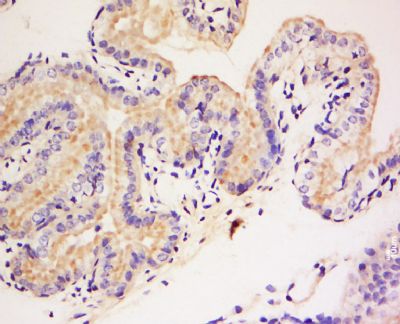DAGLB Polyclonal Antibody
Purified Rabbit Polyclonal Antibody (Pab)
- 产品详情
- 实验流程
Application
| E |
|---|---|
| Primary Accession | Q8NCG7 |
| Reactivity | Rat, Pig, Bovine |
| Host | Rabbit |
| Clonality | Polyclonal |
| Calculated MW | 73732 Da |
| Physical State | Liquid |
| Immunogen | KLH conjugated synthetic peptide derived from human DAGLB |
| Epitope Specificity | 51-150/672 |
| Isotype | IgG |
| Purity | affinity purified by Protein A |
| Buffer | 0.01M TBS (pH7.4) with 1% BSA, 0.02% Proclin300 and 50% Glycerol. |
| SUBCELLULAR LOCATION | Cell membrane. |
| SIMILARITY | Belongs to the AB hydrolase superfamily. Lipase family. |
| Important Note | This product as supplied is intended for research use only, not for use in human, therapeutic or diagnostic applications. |
| Background Descriptions | KCCR13L, is a 672 amino acid multi-pass membrane protein that belongs to the AB hydrolase superfamily. DAGL beta uses calcium as a cofactor to catalyze the hydrolysis of diacylglycerol (DAG) to 2-arachidonoyl-glycerol (2-AG), a reaction that is required for axonal growth and for retrograde synaptic signaling at mature synapses. DAGL beta functions at an optimal pH of 7 and its activity is inhibited by p-hydroxy-mercuri-benzoate and HgCl2, but not PMSF. There are three isoforms of DAGL beta that are produced as a result of alternative splicing events. |
| Gene ID | 221955 |
|---|---|
| Other Names | Diacylglycerol lipase-beta, DAGL-beta, DGL-beta, 3.1.1.-, KCCR13L, PUFA-specific triacylglycerol lipase, Sn1-specific diacylglycerol lipase beta, DAGLB |
| Dilution | ELISA=1:5000-10000 |
| Format | 0.01M TBS(pH7.4) with 1% BSA, 0.09% (W/V) sodium azide and 50% Glyce |
| Storage | Store at -20 °C for one year. Avoid repeated freeze/thaw cycles. When reconstituted in sterile pH 7.4 0.01M PBS or diluent of antibody the antibody is stable for at least two weeks at 2-4 °C. |
| Name | DAGLB |
|---|---|
| Function | Lipase that catalyzes the hydrolysis of arachidonic acid (AA)-esterified diacylglycerols (DAGs) to produce the principal endocannabinoid, 2-arachidonoylglycerol (2-AG) which can be further cleaved by downstream enzymes to release arachidonic acid (AA) for cyclooxygenase (COX)-mediated eicosanoid production (PubMed:14610053). Preferentially hydrolyzes DAGs at the sn-1 position in a calcium- dependent manner and has negligible activity against other lipids including monoacylglycerols and phospholipids (PubMed:14610053). Plays a key role in the regulation of 2-AG and AA pools utilized by COX1/2 to generate lipid mediators of macrophage and microglia inflammatory responses. Also functions as a polyunsaturated fatty acids-specific triacylglycerol lipase in macrophages. Plays an important role to support the metabolic and signaling demands of macrophages (By similarity). |
| Cellular Location | Cell membrane; Multi-pass membrane protein |
Research Areas
For Research Use Only. Not For Use In Diagnostic Procedures.
Application Protocols
Provided below are standard protocols that you may find useful for product applications.
终于等到您。ABCEPTA(百远生物)抗体产品。
点击下方“我要评价 ”按钮提交您的反馈信息,您的反馈和评价是我们最宝贵的财富之一,
我们将在1-3个工作日内处理您的反馈信息。
如有疑问,联系:0512-88856768 tech-china@abcepta.com.























 癌症的基本特征包括细胞增殖、血管生成、迁移、凋亡逃避机制和细胞永生等。找到癌症发生过程中这些通路的关键标记物和对应的抗体用于检测至关重要。
癌症的基本特征包括细胞增殖、血管生成、迁移、凋亡逃避机制和细胞永生等。找到癌症发生过程中这些通路的关键标记物和对应的抗体用于检测至关重要。 为您推荐一个泛素化位点预测神器——泛素化分析工具,可以为您的蛋白的泛素化位点作出预测和评分。
为您推荐一个泛素化位点预测神器——泛素化分析工具,可以为您的蛋白的泛素化位点作出预测和评分。 细胞自噬受体图形绘图工具为你的蛋白的细胞受体结合位点作出预测和评分,识别结合到自噬通路中的蛋白是非常重要的,便于让我们理解自噬在正常生理、病理过程中的作用,如发育、细胞分化、神经退化性疾病、压力条件下、感染和癌症。
细胞自噬受体图形绘图工具为你的蛋白的细胞受体结合位点作出预测和评分,识别结合到自噬通路中的蛋白是非常重要的,便于让我们理解自噬在正常生理、病理过程中的作用,如发育、细胞分化、神经退化性疾病、压力条件下、感染和癌症。






